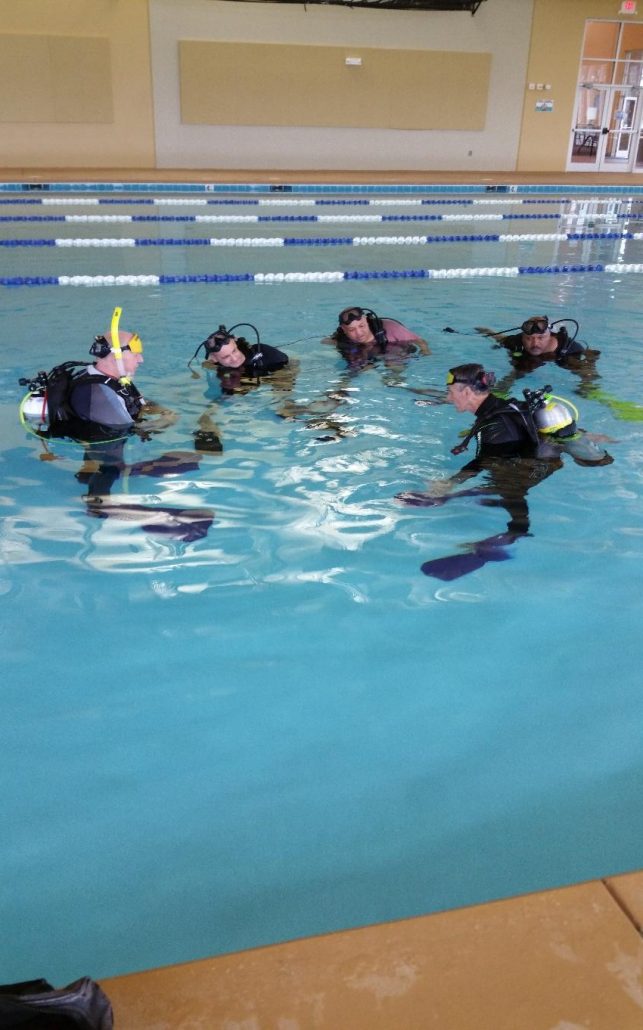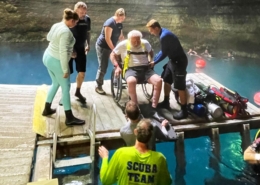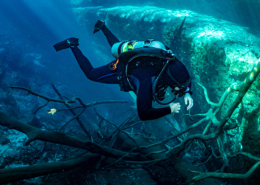Scubility, 50 First Dives
By Michael Wilkins
I became a Scubility instructor several years ago, when a friend of mine approached me and asked if I was interested in taking the Scubility Instructor Course. One of the things I experienced during my training was passive panic. I was playing the role of a blind diver and wearing a blacked-out mask to simulate that experience. All of this took place at the Blue Grotto Dive Resort, in about 25 feet of water. When my guide let go of my hand, I had no one to rely on, and no idea whether I was level, upside-down, downside-up, backward or forward. I experienced passive panic and froze in the water. This was my first introduction to how the people we work with feel when we are not in contact with them 100% of the time.
The Purple Fins Project
At the time, I had no idea how much I would fall in love with introducing diving to individuals with disabilities. It’s impossible for me to describe in words, the feeling that I get from spending time in the water doing Scubility therapy sessions. We started with a group of divers who were Scubility trained, calling ourselves the Purple Fins Project. Some of the groups we began working with were the Warrior Transition Unit in Fort Stewart, Georgia, the Mental Health Unit at NAS Jacksonville, and Eisenhower Treatment Facility, also in Jacksonville.
Shortly after my training, I had the opportunity to do a Scubility therapy session with the Warrior Transition Unit at Fort Stewart, Georgia. This experience helped cement my involvement with Scubility. We spent some time at Fort Stewart working with a number of individuals, introducing them to scuba. Several of them became interested in getting certified and we set up a weekend in Jacksonville to make that happen. There were about nine participants and one of them had a high degree of anxiety. He had a service dog that accompanied him and he would not participate in any of the group activities. He preferred to be away from the group and by himself. I was assigned to work with this individual, one-on-one, beginning with the pool activities. When we got to the Springs to complete the training, we put him in a wetsuit similar to mine. He commented that the markings on the wetsuit were similar to the outfits worn by the X-Men and wanted to get a picture of us together in the scuba gear. This was a sign that he was beginning to get comfortable, not only with the diving, but with the group as well. After the dives were completed, we sat down to do paperwork. While we were observing the divers doing paperwork, we noticed that his anxiety had dissipated and he was sitting in the middle of the group having a conversation with the others. This was significant progress and made all of us feel like we had done something special.
Working through struggles
The second experience that impacted me a great deal was a buoyancy drill we were doing in the pool. Once the clients get a sense of buoyancy, we take them out to the drop off in the pool (from 4 feet to 12 feet). We have them hover with their fingers on the edge of the 4 foot ledge. This gives them a sense of what it’s like to be weightless. On this particular day, I was having a difficult time with one of the individuals in the session. He seemed to be struggling quite a bit and holding on to some tension.
When we came to the surface to discuss it, I mentioned that he seemed a little tense and unable to control his buoyancy. He said he was having some difficulty. I told him that whatever he was holding onto, was keeping him from relaxing. He needed to trust the process and let go of whatever was holding him back. Once he did, he was able to maintain his buoyancy much more efficiently.
We have a pool session every week at Divers Supply with clients from Eisenhower Treatment Facility. I work very closely with the therapist in their facility to make sure that the breathing we are teaching in the pool is the same as what they are experiencing in therapy sessions at the treatment facility. The individuals we work with have experienced TBI, PTSD and other types of injuries. Many of them also experience a lessening of symptoms and/or pain when they are in the pool trying scuba. Watching them go from anxious and timid, to comfortable and laughing, is extremely rewarding. This training eventually becomes an instrument that can help them find a “safe place” when they are dealing with situations beyond their control.
Anxious to comfortable
One of the individuals I worked with in another class, was extremely anxious the first time she came to our facility. The first two times she had no interest in even getting in the water. She was comfortable just sitting by the side of the pool and watching what was happening. Over the span of the next month, she became one of the best at completing all of the skills we did in the pool. We do some skills with the students to make sure that they are safe while they are in the pool, but once those are completed, it becomes all about the experience.
Usually, by the third session, the more experienced people want to go to the deep end and hang out. When we hang out in the deep end, we do everything from laying on the bottom of the pool breathing to playing tic-tac-toe on dive slates or tossing around an underwater disc. After about five or six sessions, Jill went from sitting by the side of the pool to completing all of the challenges we placed in front of her.
Once she accepted the process and began to relax in the pool, everything seemed to come together for her. She ended up being one of the individuals who helped bring new people from a place of anxiety to a place of comfort. Being a part of this experience, where people you are working with are not only learning from you but helping each other, touches you in a way that is impossible to put into words. You need to experience it for yourself.
Gabriel’s story
One day, while I was at the dive shop, a young man walked in the front door and said he wanted to learn how to scuba dive. This young man made quite an impression on me. Gabriel’s right arm was paralyzed from an accident suffered while he was in the military. From day one, he poured himself into the task of becoming a certified scuba diver. There was something different about him. There was a fire inside him just waiting to grow, so I poured gasoline on it.
We set up his gear, routing all of his hoses from his regulator to the left side so he could reach them. The BC was set up so that he could control his buoyancy from his left side and pull the hose loose from his shoulder to manually inflate his BC. The last thing we did was set him up with a necklace on his primary regulator. This was only after he was able to complete all the skills, including reg recovery, to our satisfaction. He even did the BC removal and replacement underwater with one hand. I practiced all of the skills with one hand in order to demonstrate them as he would perform them — if you want to experience a challenge, place all of your hoses on the left side and practice taking your BC off and putting it back on underwater, with only your left arm. It is much more difficult than you think. Often, Gabriel came up with his own variations while performing his skills. He left us certified under Scubility as a DB1.
After he performed quite a few dives, he came back and wanted to be an Advanced Adventure Diver. Gabriel was able to complete all the skills necessary to finish the course through SDI. In many cases, due to his level of confidence, he was able to complete the skills more efficiently with one hand than an individual with two good hands (try doing your compass skills with one hand sometime). After he became an advanced diver, he traveled extensively, diving in many exotic places. He recently completed his 100th dive. Gabriel also shows up occasionally to get in the pool with the clients in our Scubility Session (they love him because he is an example of what they can accomplish).
50 First Dates
Let me close this article by giving you one more example of how much fun it is to do this. An Army veteran who had experienced TBI made a comment to me in one of the sessions. She told me that I would need to go over the same information with her next week, because she would not remember it. She referred to the movie “50 First Dates”. She said: “Yep it’s just like that.” So, we decided between the two of us that we would call her sessions “50 First Dives.”
The people that come to us for Scubility therapy sessions really enjoy the time they spend in the pool. The feedback from the therapists is very positive. It seems that thing that the clients talk about the most and are most proud of accomplishing is the mask clearing skill. It gives them a sense of confidence and completion since they need to be totally relaxed and maintain control over their minds desire to breathe in through their nose during this skill. We have worked diligently to make the program mesh with the therapy these individuals are receiving at the medical facility. We focus on breathing techniques and relaxation or letting go.
If you have the opportunity to take a Scubility course or become a Scubility Instructor, I highly recommend it. What you will give back is much more than you ever thought possible. I have spent a lot of time diving in many places around the world and I have seen a great deal of the underwater world, but I have to say that this has become my favorite diving experience. Talk to your local dive shops and find out if they have a program that you can participate in. You can get Scubility trained through SDI and begin giving back or paying it forward. You will not regret it.

















Leave a Reply
Want to join the discussion?Feel free to contribute!